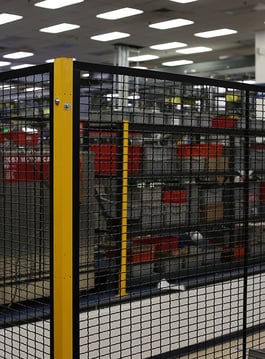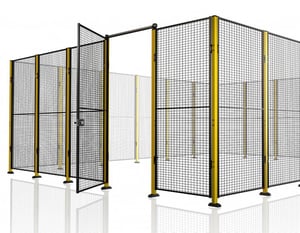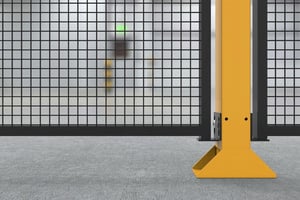In today's manufacturing environment, safety fencing plays an integral role in protecting employees from hazards posed by industrial machinery. Threats to operator safety can be found on automated machinery, process control equipment, robotic work cells, and many other areas on a manufacturing floor.
A physical barrier between hazards and operators is an effective, low-tech solution for significantly reducing the risk of injury and the costly lawsuits or machine downtime that result from these accidents.
Before implementing a safety fencing system, these five considerations should be taken into account.
The most basic step in selecting a safety fence is determining the size of the area surrounding the hazards that need guarding. Once the dimensions are known, panels and doors can be selected to best fit the area. A large variety of panel widths helps with covering areas of all shapes and sizes most efficiently.
While selecting the panel sizes, it is important to think about where the door(s) will be located. Other configurable door options to consider when designing the system are right or left-hand opening, single or double door, and a suitable handle type.
2. Height of the fencing
Choosing an appropriate fence height is important to prevent injuries that would occur from reaching over the top. The ISO 13857 standard mandates the required safety distances to prevent upper and lower limbs from contacting hazard zones. The "height of the danger zone" and the "height of the protective structure" are used to determine the required horizontal distance the fence should be from the "danger zone."
The ISO 13857 standard also includes injury risks from reaching through the fencing. For example, the steel mesh panels can have 20 mm slots. Based on this opening size, the chart says a safety distance of at least 120 mm is required. By understanding the relationship between height, opening size, and horizontal distance we can select a properly guarded fencing system.
 3. Operator safety
3. Operator safety
It is important to plan for the safety conditions required for when operators must enter the guarding system (e.g. to perform maintenance, resolve E-stop conditions, etc.). A common practice to keep operators protected is a safety interlock door handle and push buttons mounted on the post (e.g. E-stop, reset, request to enter). The signals from these are used to shut down power to potentially hazardous components while operators are in the work cell.
For many fencing systems, the end user is responsible for installing the safety interlock door handle, push buttons, and connector that runs the signals back to the safety controller. To offload this task from the end user, some fences have an option that includes a pre-wired and mounted safety interlock door handle, push buttons, and a connector to run the signals back to the safety controller.
This handy option is popular because of the reduced installation time and overall convenience a pre-wired and pre-mounted solution offers.
4. Ease of install/modularity
Most safety fencing systems are held together with a large number of nuts, bolts, and joining brackets. While simple, the installation of these systems can be tedious and time-consuming. Every single bolt has to be tightened and it can be a pain to keep the corners square. Additionally, if the system has to be expanded or re-arranged, the process of removing the hardware can be daunting.
To modernize the installation procedure, GSM has developed an innovative mounting system that requires no tools. The panels snap securely in place via quick connect fittings located on the posts. Systems that have a fast and simple connection method can be much easier to work with, especially if the system has to be expanded upon or altered.
5 . Robustness and longevity
. Robustness and longevity
Guarding systems need to be strong enough to handle unexpected collisions from personnel, carts, and even the occasional forklift. They also need to be able to last in a manufacturing environment without degrading.
An enemy to the longevity of a safety fencing system is the presence of chemicals and harsh conditions found in some manufacturing environments. Long-term exposure to these can degrade a fencing system. To prevent degradation, users should powder coat all panels and doors to ensure they will last even in the harshest environments. Powder coated steel serves as a great combination of strength and durability for a safety fencing system.
Following the steps in this guide can help you deploy a safety fencing solution that is appropriately sized, ensures operator safety, and will hold up in the environment.
Kevin Gough, account manager, Cross Company. This article originally appeared on Cross Company online. Cross Company is a CFE Media content partner. Edited by Emily Guenther, associate content manager, Control Engineering, CFE Media, eguenther@cfemedia.com
Originally Published at Control Engineering https://www.controleng.com/single-article/five-safety-fencing-benefits-and-considerations/38eea2f446c1ca6efadf9a015277fce0
To learn more about Radwell International



